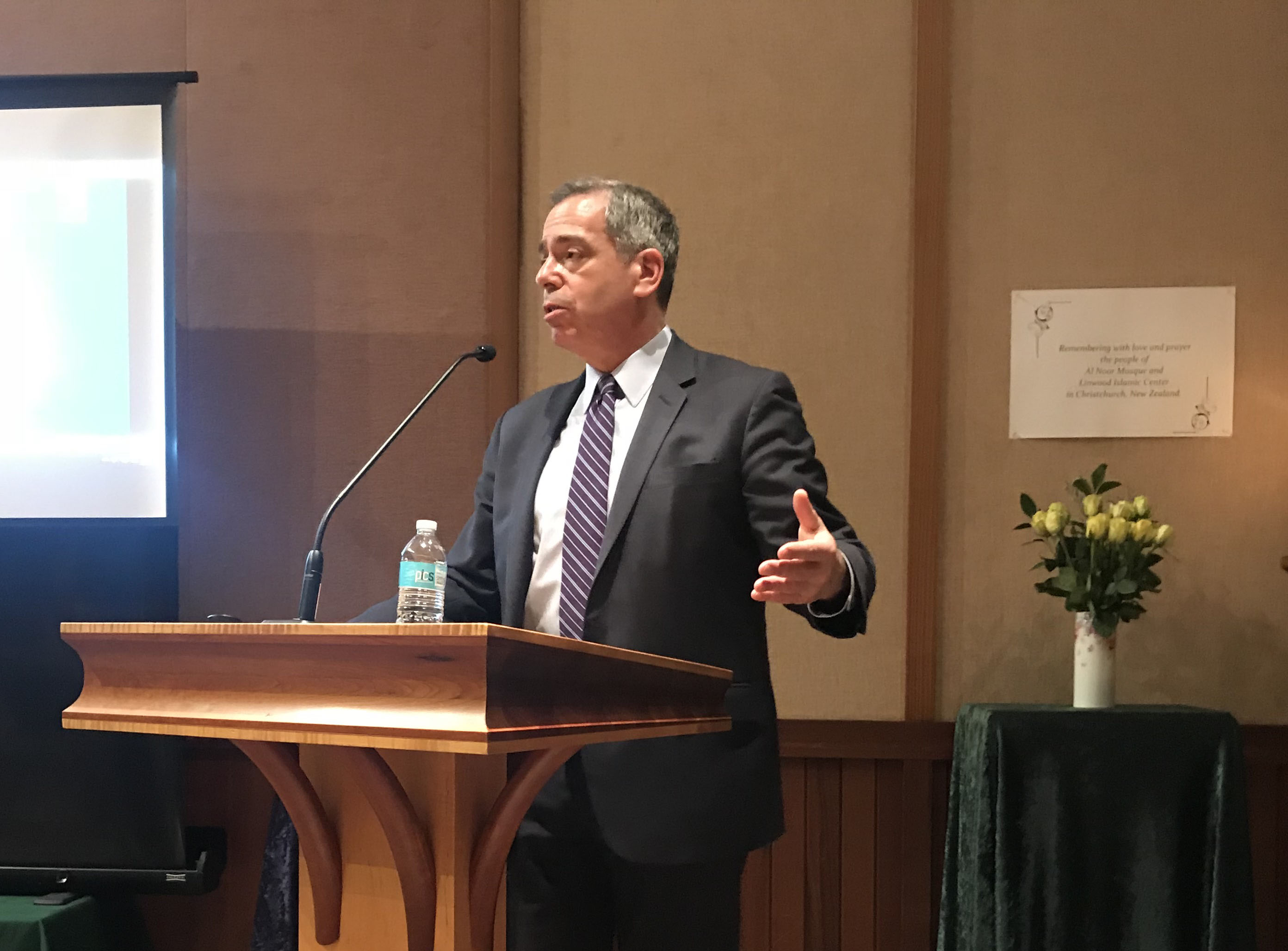By SARAH CLARK
Staff Writer
The room was heavy as lecture attendees mourned the lives lost in the recent attacks in Christchurch, New Zealand. More than ever, we face extremism daily in our personal lives and on the internet. On Monday, March 18, in the Hubbard Interfaith Sanctuary, The Sidney & Beatrice Albert Interfaith Lecture welcomed Mark Weitzman, Director of Government Affairs at the Simon Wiesenthal Center, to present on extremism and how it threatens civilizations across the world, including our own.
Weitzman helped shape the meaning of anti-semitism when the term was becoming established by the International Holocaust Remembrance Alliance, which has been adopted by twenty countries, including the European Parliament and the Department of Education. The definition is now used in court cases so that it is not easy for judges to write off hate crimes as acts of political protests.
“It opens up room for people to be protected from being falsely accused of being anti-semitic, but also opens up for a basic understanding,” says Weitzman. He uses the example of how a German court threw out convictions against two individuals in an attack on a synagogue that was ruled an act of political protest. The definition that Weitzman helped shape finally allows the government and organizations both national and international, to refer to a definition experts and political figures developed that clearly states the lines between being anti-semitic or not. “That kind of impact on countries and international organizations was something I never dreamed that I would be, to a certain extent, responsible for.”
“The extremists are people who take a belief system and push them to one side,” says Karen McGrath, a communications professor at The College of Saint Rose. Whether those beliefs are political or religious, there is danger that comes with a closed mind. “Extremism is going to exist, but we don’t have to tolerate it,” says McGrath.
“I honestly think the voices of outrage can be expressed in different ways,” says Shelly Shapiro, the Director of Community Relations at The Golub Center located in Albany, New York. The Golub Center was established to offer school programs and seminars to help inform people on the Holocaust in order to tackle racism. “Incite of hatred needs to be combated.”

Weitzman began his presentation by analyzing the recent attacks in New Zealand on the Muslims of Christchurch mosque that took place on March 15, which according to NPR, the terrorist attack took the lives of 50 people. As we see tragic incidents such as these unfold, the question still remains of how can we approach the issue of extremism.
“First of all, while this happened in New Zealand, it just shows that extremism is global,” says Weitzman. He then proceeded to show posts made by the assailant that were on an alternative right-winged site that originated from the United States. Stormfront, a major neo-nazi site, also shared the original post on their website. Similar to the New Zealand shooting, the Tree of Life synagogue shooter also used social media to post about his attacks before he committed them. “There is a component that we have to take responsibility for that begins right here at home.”
One key component of extremism today is the internet. Websites like Stormfront and other online forums can foster anger that fuels many of the attacks seen on the news. In addition to this, an increase of cellular devices and the usage of social media has created ignorance among younger generations.
“Part of it is sorting out and developing a barrier or critical sense,” says Weitzman. The reader needs to take the extra step to validate the news they receive because there is an abundance of it being published everyday by untrained internet users. This is where younger generations are negatively impacted because most time is spent mindlessly scrolling through Twitter or Instagram. “I am more concerned with what we do as individuals, and that means maybe we are forcing responsibility on people earlier than they want it, but that may be part of the price of having so much information,” says Weitzman.
“The problem is we are often not teaching [students] or they are not coming prepared when they are trying to engage in discussion,” says McGrath. She acknowledges that students do receive information, but the issue is when they are getting them from inaccurate sources that do not have the credibility. “I can ask Siri, I can go look it up on the internet, I can do any number of things, but that doesn’t mean I can understand or interpret that. I think that’s where media literacy comes in—to build those skills.”
Weitzman believes that in order to make strides in reducing extremism, there needs to be an understanding of the history. One example he uses is the Ku Klux Klan and how the group promoted ideas that, they thought, supported the vision of the Founding Fathers—not only was the group racist against people of color, but up until the late 20th century, they were also anti-semitic and anti-catholic.
As the conversation concluded, the audience was left with the message that hatred cannot be tolerated. The possibility of creating a better world is there, but it requires work from those who live in it to truly make a difference and understand how we arrived to this place of negativity. “America is a land of hope, promise, and dreams, but at the same time we cannot gloss over the dark side of America’s history.”

